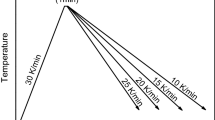Abstract
One of the main benefits of the ESR process is to obtain an ingot surface which is smooth and allows a subsequent forging operation without any surface dressing. The main influencing factor on surface quality is the precise controlling of the process such as melt rate and electrode immersion depth. However, the relatively strong cooling effect of water as a cooling medium can result in the solidification of the meniscus of the liquid steel on the boundary liquid steel and slag which is most likely the origin of surface defects. The usage of different cooling media like ionic liquids, a salt solution which can be heated up to 250 °C operating temperature, might diminish the meniscus solidification phenomenon. This paper shows the first results of the usage of an ionic liquid as a mould cooling medium. In doing so, 210 mm dia. ESR ingots were produced with the laboratory scale ESR furnace at the University of Applied Sciences Upper Austria using an ionic liquid cooling device developed by the company METTOP. For each trial melt, different inlet and outlet temperatures of the ionic liquid were chosen and the impact on the surface appearance and internal quality were analyzed. Ultimately, an effect of the usage of ionic liquids as a cooling medium could be determined and these results will be described in detail within the scope of this paper.
Zusammenfassung
Ein Hauptvorteil des ESU Prozesses ist es, eine glatte Oberfläche zu bekommen, um den ESU Block direkt einem folgendem Schmiedeprozess zuzuführen. Die präzise Kontrolle des Umschmelzprozesses ist ausschlaggebend, um eine gute Oberflächenqualität zu erreichen. Allerdings hat der relative starke Kühleffekt von Wasser als Kühlmedium der Kokille eine ebenso entscheidende Rolle für die Ausbildung der Oberfläche. Die Erstarrung des ESU Blockes beginnt hauptsächlich an der Grenzfläche flüssige Schlacke-flüssiger Stahl (Meniskusbereich). Aufgrund der Verwendung von Wasser als Kühlmittel kann es dazu führen, dass der Meniskusbereich zu schnell erstarrt und sich dadurch eine rillige Oberfläche ausbildet. Die Verwendung eines alternativen Kühlmittels, wie zum Beispiel ionische Flüssigkeiten, kann dieser Meniskuserstarrung entgegenwirken. Ionische Flüssigkeiten haben den Vorteil, dass diese sich bis zu einer Einsatztemperatur bis zu 250°C verwenden lassen. Dies hat eine sanftere Kühlwirkung zur Folge, welche sich positiv auf die Oberflächenausbildung auswirken sollte. Dieser Artikel zeigt die ersten Versuche mit einer 210 mm Kokille unter Verwendung einer ionischen Flüssigkeit als Kühlmedium. Die Versuche haben gezeigt, dass mit einer Erhöhung der Kühlmediumtemperatur die Oberflächenqualität verbessert werden kann.




Similar content being viewed by others
References
Kubin, M; Scheriau, A; Knabl, M; Holzgruber, H; Kawakami, H.: Operational experiences of large sized ESR plants and attainable quality of ESR ingots with a diameter of up to 2600 mm, Proc. of LMPC, Austin: J. Willey Pub, 2013
Hoyle, G: Surface phenomena in ESR, Proc. of 6th Vacuum Metallurgy Conference, 1979, p. 624
Mitchell, A; Smailer, R. M.: Practical aspects of electroslag remelting technology, International Reviews, 5 (1979), p. 231
Holzgruber, W: Möglichkeiten und Grenzen der Beeinflussung des Erstarrungsgefüge legierter Stähle beim Elektroschlacke-Umschmelzen, Radex Rundschau, 3 (1975), p. 409
Yu, K. O.: Macrosegregation in ESR a VAR processes, Journals of Metals, 38 (1986), no. 1, p. 46
Kou, S.; Poirier, D.; Flemmings, M. C.: Macrosegregation in Electroslag Remelted Ingots, Proc. of Electric Furnace Conference, 35 (1977), p.221
Thielmann, R.; Kreyenberg, J.: Investigation of parameters influencing ESR economy and ingot quality, Proc. of 8 th ICVM Special melting/refining and metallurgical coating under vacuum or controlled atmosphere, 1985, p. 1130
Bordin, I. P.; Goryainov, V. A.; Koshman, V. S.; Zaitseva, L. A., Tsapaeva, L. L.: Influence of solidification conditions on dentritic structure and segregation of elements in electroslag remelted ingots,Steel in the USSR ,15 (1985), p. 533
Author information
Authors and Affiliations
Corresponding author
Rights and permissions
About this article
Cite this article
Kubin, M., Ofner, B., Holzgruber, H. et al. The Influence of the Mould Cooling Temperature on the Surface Appearance and the Internal Quality of ESR Ingots. Berg Huettenmaenn Monatsh 161 (Suppl 1), 34–38 (2016). https://doi.org/10.1007/s00501-016-0484-4
Received:
Accepted:
Published:
Issue Date:
DOI: https://doi.org/10.1007/s00501-016-0484-4
Keywords
- Electro slag remelting
- Ionic liquids
- Surface appearance
- Liquid metal pool depth
- Secondary dendrite arm spacing




